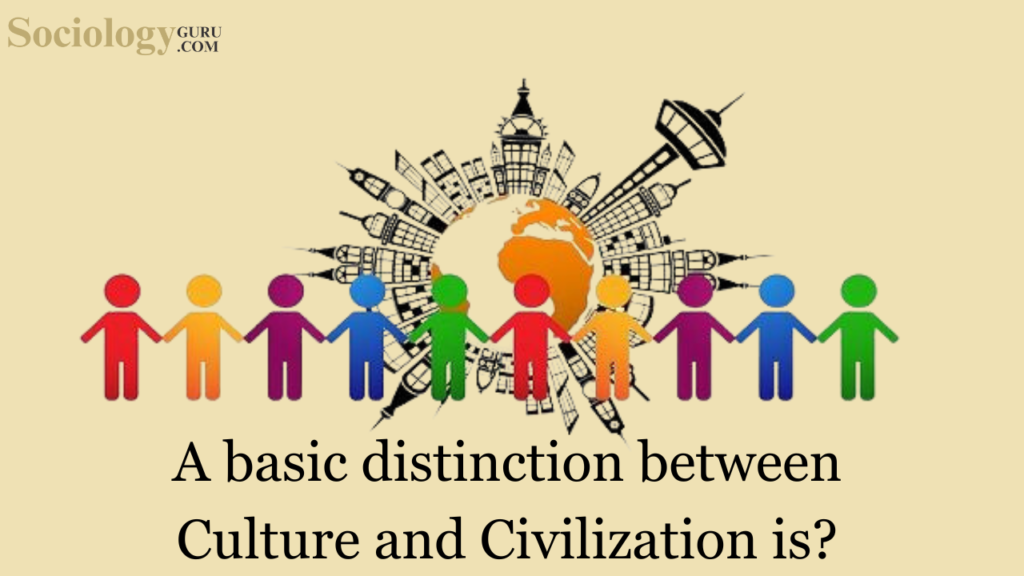Question: A……..is a specific guide to action which defines acceptable and appropriate behaviour in particular situations.
- Custom
- Value
- Culture
- Norm
Answer: (4)Introduction:In the realm of social sciences, understanding the dynamics of human behavior is essential for comprehending the intricacies of societies and cultures. The question posed in the MA CUET exam delves into a fundamental aspect of societal regulation – social norms. This essay aims to provide a comprehensive analysis of the concept of social norms and their pivotal role in guiding human behavior. Defining Social Norms:A social norm can be understood as a specific guide to action that defines acceptable and appropriate behavior in particular situations. It serves as a shared standard within a group, shaping the conduct of its members. Social norms can be informal, representing the unwritten rules governing behavior within a society. Additionally, they can be formalized into rules and laws that codify expected conduct. Nature of Social Norms:Social norms play a crucial role in maintaining social order and cohesion. They are the invisible threads that weave individuals into a unified fabric of a community. These norms serve as the foundation for interactions, communication, and cooperation among members of a society. Without such shared expectations, social life would be chaotic and unpredictable. Types of Social Norms:Social norms can be categorized into various types based on their nature and application. Some norms are descriptive, reflecting what people commonly do in a given situation. Others are prescriptive, dictating what individuals ought to do. Understanding these distinctions is essential for grasping the multifaceted nature of social norms. Social Normative Influences:The question emphasizes the influence of social norms on human behavior. Indeed, social normative influences are powerful drivers of behavioral changes. Numerous theories in psychology and sociology posit that individuals are strongly influenced by the norms prevalent in their social environment. Conformity to these norms is seen as a mechanism for social acceptance and integration. Theoretical Frameworks:Major theories explaining human behavior, such as social identity theory, social learning theory, and social cognitive theory, incorporate the concept of social norms. These theories recognize the impact of group dynamics and societal expectations on individual behavior. For example, social learning theory asserts that individuals acquire new behaviors by observing and imitating the actions of others within their social context. Institutionalization of Norms:Institutions, as complex social structures, are composed of multiple norms. Whether it be educational institutions, legal systems, or religious organizations, norms shape the conduct of individuals within these settings. The institutionalization of norms provides a formalized framework for guiding behavior, often through the creation of rules and regulations. Contextual Nature of Norms:Norms are not static; their acceptability and appropriateness are contingent on various factors, including context, social group, and historical circumstances. What may be considered acceptable behavior in one culture or community might be viewed differently in another. Recognizing the contextual nature of norms is essential for understanding the diversity of human behavior across different societies. Distinguishing Norms from Other Concepts:To fully comprehend the concept of social norms, it is crucial to distinguish them from related terms such as ideas, attitudes, and values. Norms specifically pertain to shared social beliefs about behavior, distinguishing them from private beliefs held by individuals. While ideas, attitudes, and values may influence behavior, norms directly guide and regulate it within a social context. Conclusion:In conclusion, the concept of social norms is integral to understanding human behavior within societal frameworks. Social norms serve as specific guides to action, defining acceptable and appropriate behavior in various situations. They are the foundation of social order, influencing individual conduct and shaping the dynamics of communities. The contextual nature of norms, their institutionalization, and their integration into major theoretical frameworks highlight their significance in the study of human behavior. As aspiring scholars preparing for the MA CUET exam, a nuanced understanding of social norms will undoubtedly contribute to a deeper comprehension of societal structures and interactions. |
Take a Quick Sociology Quiz to measure your Performance
Frequently Asked Questions:
1. Question: Define the term “ethnic movement” and provide an example from India.
Answer: An ethnic movement refers to a collective effort by a group sharing common cultural, linguistic, or religious traits, seeking to assert their identity and rights; an example from India is the Khalistan Movement in Punjab.
2. Question: Identify the main objectives behind the Gorkhaland ethnic movement.
Answer: The Gorkhaland ethnic movement primarily seeks to establish a separate state for India’s Nepali-speaking population in the Darjeeling region, advocating for linguistic and cultural recognition and political autonomy.
3. Question: What was the Operation Blue Star, and which ethnic movement was it related to?
Answer: Operation Blue Star was a military action in 1984, aiming to remove Sikh militants hiding in the Golden Temple in Amritsar; it is related to the Khalistan movement, which sought a separate Sikh country.
4. Question: Mention a critical factor that triggered the emergence of ethnic movements in India, as discussed by Dipankar Gupta.
Answer: Dipankar Gupta emphasized that ethnicity is fundamentally a political process, wherein caste and religion, the key components of identity formation, are politicized by leaders for vested interests.
5. Question: What were the primary reasons for the Assam Ethnicity conflicts involving Bodo tribals and Bengali Muslim settlers?
Answer: The Assam Ethnicity conflicts primarily stemmed from issues related to immigration, land rights, and resource allocation, leading to clashes, riots, and evolving relationships among indigenous communities to address challenges.
6. Question: Briefly describe the role of the Dravidian Movement in terms of caste and societal structure.
Answer: The Dravidian Movement, led notably by E.V. Ramasamy, aimed to establish an egalitarian society, focusing on anti-Brahmanism and advocating for equal rights for backward castes, while also introducing reforms like self-respect marriages.
7. Question: Name the prominent ethnic movements in North-East India and specify one common objective.
Answer: Prominent ethnic movements in North-East India include the Nagas’ and Mizos’ struggles; a common objective was to gain autonomy and recognition for their distinct tribal identities and cultural uniqueness.
8. Question: What is the key argument of Gail Omveldt regarding traditional Indian society and multiculturalism?
Answer: Gail Omveldt opposed romanticizing traditional Indian society, arguing that hierarchy has always dominated it and dismissing the notion that multiculturalism is an intrinsic feature of Indian society as a myth.
9. Question: Briefly explain the social hierarchy factor as a contributing element to ethnic movements as suggested by Olzak.
Answer: Olzak suggests that the construction of hierarchies among ethnic communities, which often leads to the suppression of one group by another, is a key factor that can instigate social and ethnic movements.
10. Question: Identify one consequence of the unequal economic development factor within the context of ethnic movements in India.
Answer: One consequence of unequal economic development is the marginalization and underdevelopment of certain groups, leading to feelings of alienation and sometimes initiating ethnic movements as these groups strive for equality and recognition.
To master these intricacies and fare well in the Sociology Syllabus, aspiring sociologists might benefit from guidance by the Best Sociology Teacher and participation in the Best Sociology Coaching. These avenues provide comprehensive assistance, ensuring a solid understanding of sociology’s diverse methodologies and techniques.
META TAGS:
Why Vikash Ranjan’s Classes for Sociology?
Proper guidance and assistance are required to learn the skill of interlinking current happenings with the conventional topics. VIKASH RANJAN SIR at SOCIOLOGY GURU guides students according to the Recent Trends, making him the Best Sociology Teacher for Sociology.
At Sociology Guru, the Best Sociology Coaching platform, we not only provide the best study material and applied classes for Sociology but also conduct regular assignments and class tests to assess candidates’ writing skills and understanding of the subject.
Choose The Best Sociology Teacher for your Preparation?
To master these intricacies and fare well in the Sociology Syllabus, aspiring sociologists might benefit from guidance by the Best Sociology Teacher and participation in the Best Sociology Coaching. These avenues provide comprehensive assistance, ensuring a solid understanding of sociology’s diverse methodologies and techniques. Sociology, Social theory, Best Sociology Teacher, Best Sociology Coaching, Sociology Syllabus.
Best Sociology Teacher, Sociology Syllabus, Sociology, Sociology Coaching, Best Sociology Coaching, Best Sociology Teacher, Sociology Course, Sociology Teacher, Sociology Foundation, Sociology Foundation Course, Sociology CUET, Sociology for IAS, Sociology for UPSC, Sociology for BPSC, Sociology for UGC NET, Sociology for JPSC,
Follow us :
KEYWORD:-Appropriate Behaviour, Appropriate Behaviour, Appropriate Behaviour, Appropriate Behaviour, Appropriate Behaviour, Appropriate Behaviour, Appropriate Behaviour, Appropriate Behaviour, Appropriate Behaviour, Appropriate Behaviour, Appropriate Behaviour, Appropriate Behaviour, Appropriate Behaviour, Appropriate Behaviour, Appropriate Behaviour, Appropriate Behaviour, MA CUET SOCIOLOGY



